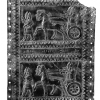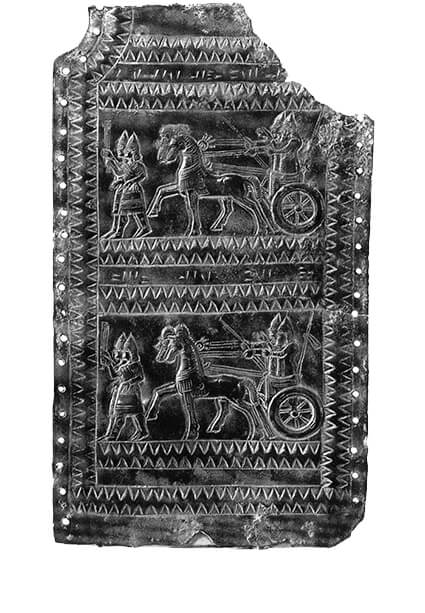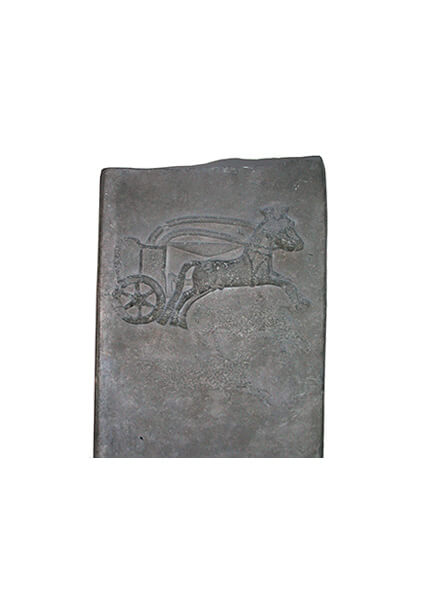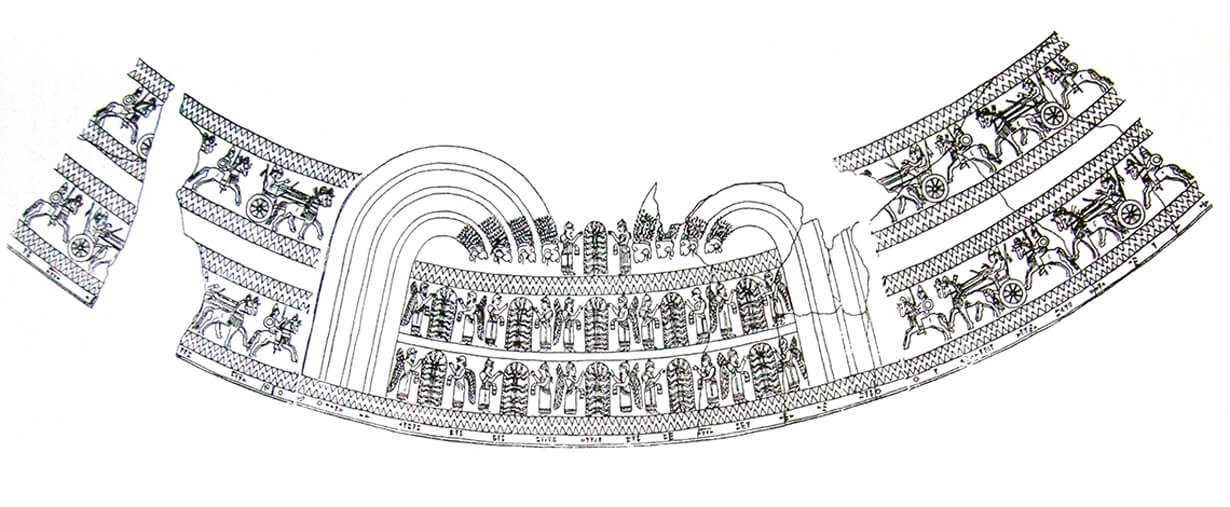One can say about the structural character of the Urartian army based upon arms and horse harnesses found out in Urartian settlement areas and necropolises and the depictions of war and soldiers on the Urartian bronze artifacts along with Urartu and Assyria written sources.
The religious nature of the army is always emphasized. The king goes on expedition with the order and power of God. Sometimes, God Haldi, himself goes on an expedition with his spear. This situation is also visually depicted in a battle scene on the Anzaf Shield. At the front, God Haldi attacks the enemy army with his flaming spear, spreading flames from all over his body. Teişeba (Storm God) and Şiuini (Sun God) following him strengthen the spiritual/divine power and might of the Haldi and the Urartian army. Further behind, the other Urartian gods are also lined up with weapons in their hands. The sanctity of war is often emphasized in both the inscriptions and in the art of Urartian depiction.
The King is the commander-in-chief in the expedition inscriptions with the permission of the god Haldi. He commands the army in the name of God. Anals that were written by I. Argişti and II. Sarduri more regularly and systematically by influencing from the Assyrian tradition, reflects the war routine of the God, King/Commander-in-Chief and the Urartian army again and again. As a result of this stereotyped expression, the enemy received a heavy defeat against the Urartu army each time.
God Haldi went on an expedition with his sword, captured Mana country, laid Buštu country to the feet of Argišti. With the greatness of God Haldi, Argišti says; I begged the Lord God Haldi, the Storm God, the Sun God (and) the (all) Gods of theBiainili Country (?). The gods heard my voice. Minua, the son of Argišti, says: God Haldi is strong. God Haldi's sword is strong.
With the greatness of God Haldi, I went on an expedition on Buštu Country. I have captured Aškaiai Valley. I went on up to the Uišini Country extending to the left side from the right of Šatiraraga Country? and below the Ugišti Country and mountainous Alati Country(?).I burned the country, destroyed the cities. I deported men and women. (I have captured) 7873 people in total that year. I killed some of it, I deported other survivor part. (I have captured) and deported 2?90 horses, 101 camels, 4909 cattles, 19550 sheeps.
It can be said that the Urartian war forces are composed of several sources. It is possible to talk about the military units that were formed in case of war or defense rather than regular army. It is understood that in certain periods of the year, some communities were responsible for providing soldiers to the army and in this way they gained some privileges and exemptions. Particularly in the summer months, the central units connected to the kingdom were included in the expedition program. These were probably farmers, animal owners or shepherds in Urartu society, except in these special cases.
States are important military resources. They had a certain amount of soldiers, the provincial governors gathered soldiers in the course of war. Another important source of soldiers must have been the tribes. Among the expedition route, the tribes affiliated with Urartu were likely participate in these expeditions because of their military obligations or to receive share from spoils.
Some inscriptions on the period of joint management of Ispini and Minua give information about the numerical dimensions of the army. In an inscription found in a church in the Old Van City, it is stated that the Urartian army consisted of 66 chariots, X thousands 460 cavalry and 15.760 infantry. The same content was repeated in the Kasımoğlu stela.
Another important source for the size and weapons of the army was consisted of the Analı Kız inscriptions, in which Sarduri tells his expeditions. Discussions about the definitions mentioned are still up-to-date. Are they those which make up the army and the requirements/amounts spent by the army, or the spoils captured by the army?
92 chariots, 3600 cavalry, 352011 horsemen and infantry soldiers,from them the ardaie soldiers ...turubi, I threw this isiuse....?.. 121 people, 10408 horses, 132 camels, 12321 cows, 9036 bulls, 21357 cattles in total, 35467 sheeps, 2114 war weapons, 1332 bow, 47970 arrow, 122133 kapi arpa, 111 aqarqi wine, 86 aqarqi 7 tirusi mankali oil, 7079 MA.NA bronze, 336 Ururda man... turubi.
From the inscriptions and descriptions, the three main units can be defined in the Urartu army. The beginning of these is chariots. In the chariot which is pulled by two horses, there is usually an archer with a driver. From the depictions and excavations, it is understood that these tools are quite decorated. It is clear that the car case, the car arrow, and the items and ornaments carried by the horse can significantly reduce the maneuverability of the vehicle on the battlefield. Prestige and propaganda aspects dominate, and it is foreseen that such vehicles are not much preferred on the battlefield.
The second important group of the army consists from the cavalries. They are sometimes subjected to different classifications with the weapons they carry. Those carrying bow, those carrying spear, those carrying shield and those carrying both of them. These differences may be related to the approaches in the depiction understanding.
The infantry is the largest group in the army. From the depictions, it can be said that they have spear, shield or bow and arrow.

AT KOŞUM TAKIMI

STEL VAN MÜZESİ







